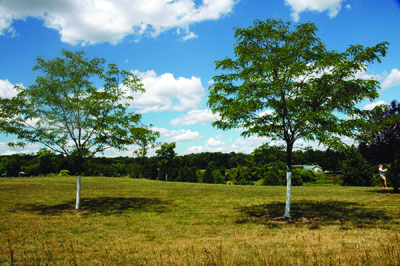Smart Tree Tip Sheets
 A smart urban or community landscape has a diverse combination of trees. The devastation caused by exotic pests such as Dutch elm disease, chestnut blight and emerald ash borer has taught us the importance of species diversity in our landscapes. Exotic invasive pests can devastate existing trees because many of these species may not have evolved resistance mechanisms in their native environments. In the recent case of emerald ash borer, white ash and green ash were not resistant to the pest and some communities in Michigan lost up to 20 percent of their tree cover. To promote diverse use of trees by homeowners, landscapers and urban foresters, MSU Extension offers a series of tip sheets for smart urban and community tree selection.
A smart urban or community landscape has a diverse combination of trees. The devastation caused by exotic pests such as Dutch elm disease, chestnut blight and emerald ash borer has taught us the importance of species diversity in our landscapes. Exotic invasive pests can devastate existing trees because many of these species may not have evolved resistance mechanisms in their native environments. In the recent case of emerald ash borer, white ash and green ash were not resistant to the pest and some communities in Michigan lost up to 20 percent of their tree cover. To promote diverse use of trees by homeowners, landscapers and urban foresters, MSU Extension offers a series of tip sheets for smart urban and community tree selection.
In these tip sheets, we suggest trees that should be considered in situations where an ash tree may have been planted in the past. We have limited the tip sheets to medium to large trees that fulfill similar design intent as ashes. We include information on general characteristics, hardiness, mature form, size and other noteworthy qualities. For species native to eastern North America, we provide a map of the species’ native range. We tried to present a representative number of “tried and true” trees and some lesser-known or underused selections suitable for Michigan. Smart tree selection is guided by Right Plant/Right Place and Responsible Use: selecting trees based on a tree’s functional use, aesthetics, adaptability and environmental contributions to the immediate site and surrounding areas. Our tip sheets focus on the species level, although we do mention cultivars of several species. The following trees are recommended and featured in a tip sheet:
- American elm, Ulmus americana
- American hornbeam, Carpinus caroliniana
- American hophornbeam, Ostrya virginiana
- Amur corktree, Phellodendron amurense
- Baldcypress, Taxodium distichum
- Basswood or American Linden, Tilia americana
- Bur oak, Quercus macrocarpa
- Chinkapin oak, Quercus muehlenbergii
- Dawn redwood, Metasequoia glyptostroboides
- European hornbeam, Carpinus betulus
- Freeman maple, Acer ×freemanii
- Ginkgo, Ginkgo biloba
- Hackberry, Celtis occidentalis
- Hardy rubber tree, Eucommia ulmoides
- Hedge maple, Acer campestre
- Honeylocust, Gleditsia triacanthos
- Hybrid elms, Ulmus spp.
- Japanese pagodatree, Sophora japonica
- Katsura tree, Cercidiphyllum japonicum
- Kentucky coffeetree, Gymnocladus dioicus
- Little-leaf linden, Tilia cordata
- London planetree, Platanus ×acerifolia
- Miyabe maple, Acer miyabei
- Northern pin oak, Quercus ellipsoidalis
- Red maple, Acer rubrum
- Scarlet oak, Quercus coccinea
- Shantung maple, Acer truncatum
- Shingle oak, Quercus imbricaria
- Silver linden, Tilia tomentosa
- Swamp white oak, Quercus bicolor
- Sweetgum, Liquidambar styraciflua
- Sycamore maple, Acer psuedoplatanus
- Trident maple, Acer buergerianum
- Tulip tree, Liriodendron tulipifera
- Tupelo, Nyssa sylvatica
- Turkish hazel, Corylus colurna
- Yellowwood, Cladrastis kentukea



 Print
Print Email
Email